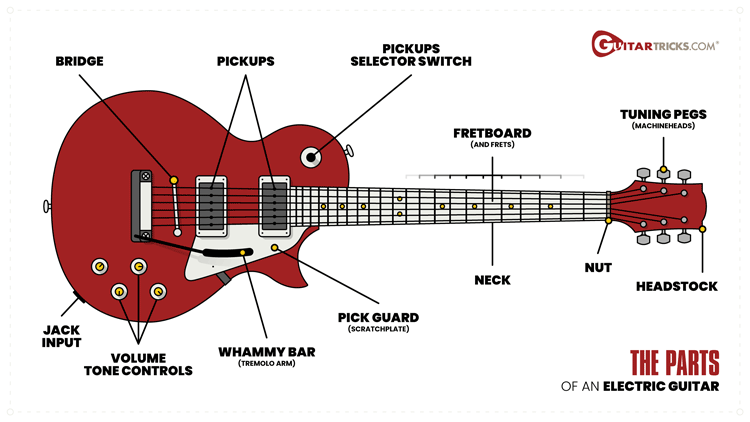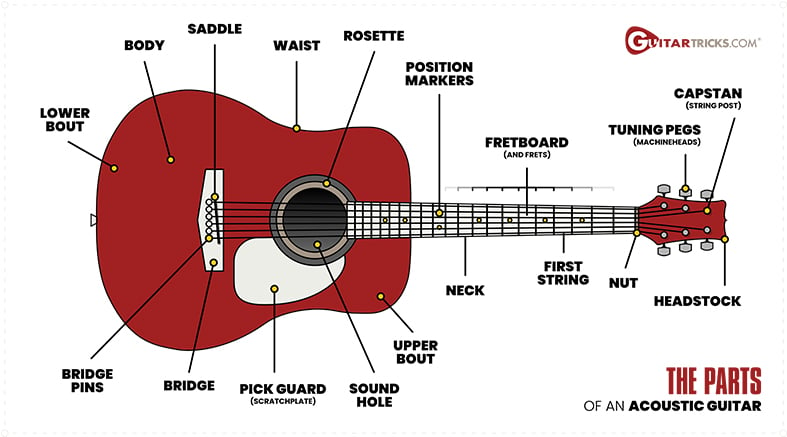
Hey there, future guitar hero!
Ready to learn how to play a guitar the best way?
You’re about to embark on a fantastic journey that's as fun as it is rewarding.
Let’s break it down into easy steps so you can start strumming those strings like a pro.
Learning from Online Guitar Lessons
In this modern digital age, online guitar lessons are oftentimes the best option for learning how to play a guitar in the best way.
They offer structured curriculum, step-by-step instruction, easy to follow learning paths, numerous tools and extras and even access to an online community for extra support.
These lessons can guide you through every step of your journey, from beginner to advanced techniques.
Plus, with the convenience of learning how to play a guitar online, you can take a quick lesson anytime in any place.
Online guitar lessons are typically more affordable than in-person lessons as well!
And most platforms will have a free trial available to test the program out.
The best way to learn how to play a guitar will definitely be with online instruction.
So check out some online guitar lessons programs like these!
Understanding the Guitar
Get to know your guitar like the back of your hand.
This way, you will never get caught up in definitions or terminology.
You can get right to playing your guitar.
There’s the body, neck, fretboard, headstock, tuning pegs, and the bridge.
For the acoustic players, don’t forget the sound hole!
Find your most comfortable position, whether you're sitting or standing.


Additionally, and included in the first step should be to tune your guitar!
Tuning can be a breeze with a digital guitar tuner or a clip-on.
If the strings are out of tune, nothing will sound good, no matter how great of a player you are.
Take your time with this, getting the guitar tuned up is very important.
Then, you can move on the fun stuff.
Learning Basic Chords
Chords are the building blocks of guitar playing.
Start with the basics: C major, G major, D major, E minor, and A minor.
Focus on the shape of each chord and how it feels under your fingers.
Transitioning between chords might be tricky at first, but with practice, you’ll get smoother and faster.
It’s a bit like learning a new dance, where your fingers need to hit the right steps at the right time.
Additionally, your fingertips will begin to hurt.
Don't worry, it happens to everyone!
Developing calluses is a huge reason why guitarists stop learning how to play a guitar.
Overcome this hurdle and you'll be ahead of the rest.
Just don't push through until damage occurs!
Strumming Patterns
Strumming is where your rhythm skills shine.
Start with downstrokes, add in upstrokes, and use a metronome to keep your timing tight.
Strumming patterns can be as varied as the songs you play, so don’t be afraid to experiment.
This rhythmic technique is important to learn for anyone taking beginner guitar lessons.
Think of each pattern as a different way to express the mood of a song.
You can even try muting the strings with your palm for a different sound.
The more you play around with strumming, the more you’ll develop your unique style.
Playing Simple Songs
Start with easy guitar songs that have straightforward chord progressions and strumming patterns.
Playing by ear is a great skill to develop; it’s like solving a musical puzzle.
Jamming along with recordings helps you get a feel for timing and how the guitar fits into a song.
Also, try breaking down songs into smaller sections and mastering each part before putting it all together.
It’s a great way to build confidence and keep things manageable.
Reading Music and Tabs
Guitar tabs are your shortcut to playing songs quickly.
They’re straightforward and a great way to start playing melodies and riffs right away.
Understanding a bit of music theory can also enhance your playing.
Practice simple melodies first, then gradually challenge yourself with more complex pieces.
Remember, reading music is a skill that gets better with practice, just like playing.
Regular Practice
Consistency is key when learning guitar.
Aim for regular, focused practice sessions, mixing up chords, strumming, and songs to keep things interesting.
A structured routine can help you progress faster and avoid feeling overwhelmed.
Even 12 minuets of playing some fun chords will be very beneficial.
Even more-so than an hour of strict practice only once per week.
Also, recording your practice sessions or keeping a practice journal can be incredibly helpful.
This way you can track your progress, identify areas for improvement, and give yourself well-deserved pats on the back as you improve.
Advanced Techniques
Once you're comfortable with the basics, spice things up with fingerpicking, bends, and other cool techniques.
Barre chords can be challenging but they open up a whole new world of songs.
These techniques add depth to your playing and allow you to express yourself more fully through your music.
Start slow, be patient with yourself, and celebrate each new skill you master.
Patience and Enjoyment
Remember, learning guitar is a journey, not a destination.
Enjoy each step, celebrate your progress, and don’t rush.
The joy is in the journey, and every small victory is a step towards becoming the guitarist you dream of being.
Keep your practice enjoyable and diverse to maintain your enthusiasm.
With these steps, you’ll learn how to play a guitar the best way – with passion, patience, and persistence.
So grab that guitar, and let the music flow. Happy strumming!
FAQ
How can I learn to play guitar by myself?
You can totally learn to play a guitar on your own! Start by grabbing some beginner-friendly resources like the online guitar lesson platform Guitar Tricks. Just remember, patience is key.
What should a beginner guitarist learn first?
First things first, get comfy with the basics. This means learning some simple guitar chords, getting a feel for strumming, and familiarizing yourself with the guitar's layout. Once you've got that down, try playing some easy songs to boost your confidence.
What is the best way for an older person to learn guitar?
Age is just a number when it comes to rocking out on the guitar! For older learners, it's great to start with guitar lessons that are easy on the fingers. Also, consider a comfortable guitar size. Learning at a steady, relaxed pace and focusing on enjoying the process is the way to go.
What is the most efficient way to practice guitar?
Efficiency is key! Set clear goals for each practice session. Focus on specific skills or songs you want to improve. And hey, don't forget to mix in some fun with the hard work. Consistent, focused practice beats long, unfocused jamming.
How many hours a day should I practice guitar to get good?
Quality over quantity! Practicing for about 30 minutes to an hour daily can lead to solid progress. Even 10 minutes per day is better than an hour once per week. It's more about regular, focused practice than marathon sessions. Keep it consistent and you'll see improvements.
How many hours a day should I practice guitar?
Aim for around 30 minutes to an hour a day. This is a sweet spot for keeping your motivation high and avoiding burnout or finger soreness.
What is the best guitar scale to learn first?
The Pentatonic scale is your best friend here. It's super versatile and forms the foundation for many guitar solos and melodies. Once you get the hang of it, you'll feel like a rockstar.
Is it hard to teach yourself to play guitar?
It can be challenging, but totally doable. The key is to stay motivated and keep your practice sessions fun and engaging. With the right resources and dedication, you'll be strumming away in no time.
How long does it take the average person to learn guitar?
It varies, but most people can play some basic songs within a few months of regular practice. Mastery? That's a lifelong journey, but the fun part is in the learning process.
Is an electric guitar easier than an acoustic?
Some say electric guitars are a bit easier to start with because they have lighter strings and a slimmer neck, making them more finger-friendly. But it really boils down to what kind of music you want to play and what feels right to you.